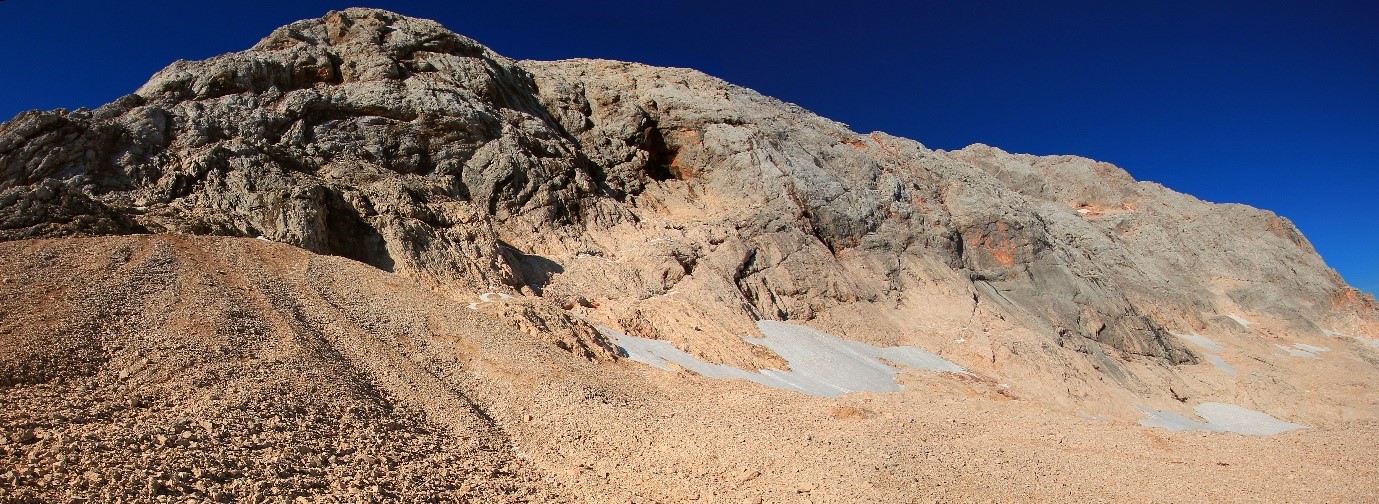Cryosphere

Cryosphere science, the study of Earth's frozen water in all its forms, holds significant importance both for Slovenia and on a global scale. Globally, cryosphere science is pivotal for understanding the Earth's climate system, as changes in ice and snow cover affect global albedo, sea levels, and ocean circulation patterns. The polar ice caps and glaciers are among the most sensitive indicators of climate change, with their accelerated melting contributing to rising sea levels, threatening coastal communities and ecosystems worldwide. In Slovenia, a country with high mountain ranges like the Julian Alps, cryospheric elements such as glaciers and snow cover play a crucial role in landscape evolution. The Triglav Glacier, Slovenia's renowned ice mass remnant of once larger glacier, serves as a sentinel of climate change, with its fluctuations providing valuable insights into regional climatic shifts.
Recent projects:
- Supporting Holocene Climate Reconstruction with High-Resolution Cryospheric Proxies from the Karst Ice Caves of Slovenia - Slovenian Research and Innovation Agency - 2023-2026
- The impact of climate change on avalanches in Slovenia - Slovenian Research and Innovation Agency - 2022-2025
- Subglacial carbonate deposits - a new source for studying the presence of glaciers in a glaciokarstic environment - Slovenian Research and Innovation Agency - 2021-2024
- Research of the Slovenian glaciers - Slovenian Research and Innovation Agency – since 1946, ongoing.
Recent outputs:
- Lipar, M, Zorn, M, Ferk, M, Cof, K, Čretnik, M (2025). The susceptibility of subglacial carbonates to frost weathering. Earth Surface Processes and Landforms, 50, doi: https://doi.org/10.1002/esp.70055
- Smith, DF, Lyons, WB, Welch, SA, Zorn, M, Tičar, J, Lipar, M, Carey, AE (2023). The chemistry of cave ice : two examples from Slovenia. Environmental & Engineering Geoscience, 29, doi: https://doi.org/10.2113/EEG-D-23-00001
- Komac, B, Zorn, M (2023). Impact of climate change on snowpack and avalanches in Slovenia : the Soča Valley case study. Geographia Polonica, 96, doi: https://doi.org/10.7163/GPol.0244
- Lipar, M, Zorn, M (2022). The glaciological year 2021-22 at Triglav glacier. Meteorologica : bollettino dell'Unione meteorologica del Friuli Venezia Giulia, 23, link: https://f689bf06-f0ec-49f5-8bab-b30e896110da.filesusr.com/ugd/207002_a558f5d6d5254e7f86303f2521c7095b.pdf
- Lipar, M, Zorn, M, Perko, D (2021). Ice Caves. In: The International Encyclopedia of Geography: People, the Earth, Environment, and Technology, John Wiley & Sons, Ltd., doi: https://doi.org/10.1002/9781118786352.wbieg2038
- Lipar, M, Martín-Pérez, A, Tičar, J, Pavšek, M, Gabrovec, M, Hrvatin, M, Komac, B, Zorn, M, Zupan Hajna, N, Zhao, J-x, Drysdale, RN, Ferk, M (2021). Subglacial carbonate deposits as a potential proxy for a glacier’s former presence. The Cryosphere, 15, doi: https://doi.org/10.5194/tc-15-17-2021
- Carey, AE, Smith, DF, Welch, SA, Zorn, M, Tičar, J, Lipar, M, Komac, B, Lyons, WB (2020). The geochemistry of ice in the southeastern Alps, Slovenia. Acta geographica Slovenica, 60, doi: https://doi.org/10.3986/AGS.7420
- Triglav Čekada, M, Zorn, M (2020). Thickness and geodetic mass balance changes for the Triglav Glacier (southeastern Alps) from 1952 to 2016. Acta geographica Slovenica, 60, doi: https://doi.org/10.3986/AGS.7673
- Triglav Čekada, M, Barbo, P, Pavšek, M, Zorn, M (2020). Changes in the Skuta Glacier (southeastern Alps) assessed using non-metric images. Acta geographica Slovenica, 60, doi: https://doi.org/10.3986/AGS.7674
- Carey, AE, Zorn, M, Tičar, J, Lipar, M, Komac, B, Welch, SA, Smirh, DF, Lyons, WB (2019). Glaciochemistry of cave ice : Paradana and Snežna Caves, Slovenia. Geosciences, 9, doi: https://doi.org/10.3390/geosciences9020094